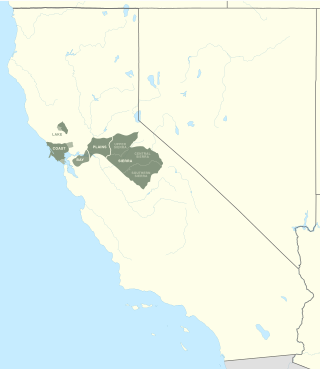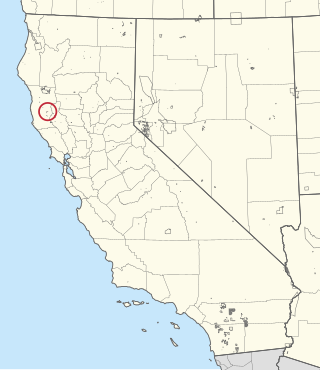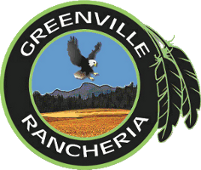
Shingle Springs is a census-designated place (CDP) in El Dorado County, California, United States. The population was 4,432 at the 2010 census, up from 2,643 at the 2000 census. It is located about 40 miles (64 km) from Sacramento in the Gold Country foothills and sits directly on Highway 50. The towns of Coloma and Placerville are less than 15 miles (24 km) away.

The Miwok are members of four linguistically related Native American groups Indigenous to what is now Northern California, who traditionally spoke one of the Miwok languages in the Utian family. The word Miwok means people in the Miwok languages.

The Maidu are a Native American people of northern California. They reside in the central Sierra Nevada, in the watershed area of the Feather and American Rivers and in Humbug Valley. In Maiduan languages, maidu means "man".
The Ione Band of Miwok Indians is a federally recognized tribe of Miwok people in Amador County, California. As of the 2010 census the population was only 5.
The Tuolumne Band of Me-Wuk Indians is a federally recognized tribe of Miwok people in Tuolumne County, California. The Tuolumne Band are central Sierra Miwok people. Annually, in September, the tribe holds an acorn festival and intertribal gathering.

The Patwin are a band of Wintun people in Northern California. The Patwin comprise the southern branch of the Wintun group, native inhabitants of California since approximately 500.

Harry Eugene Fonseca was a Nisenan Native American artist, and illustrator. He was an enrolled citizen of the Shingle Springs Band of Miwok Indians.

The Nisenan are a group of Native Americans and an Indigenous people of California from the Yuba River and American River watersheds in Northern California and the California Central Valley. According to a 1929 archeology and ethnology press release by University of California, Berkeley, the Nisenan people are classified as part of the larger group of Native Americans known as the Maidu, though some dispute the accuracy of this relationship, including the Nisesan themselves. According to the Nisenan website, the United States' claim that they are Maidu is a misclassification and is inaccurate. As the Nisenan put it,
"Like many other Tribes throughout the United States, the Nisenan have been misidentified and mislabeled. The Nisenan have been lumped together under inaccurate labels such as "Maidu", "digger" and "southern Maidu". However, the Nisenan are a separate Tribe with their own Cultural lifeways, their own leaders and holy people, a distinct geographic territory and their own ancient and unique language."

The Plains and Sierra Miwok were once the largest group of California Indian Miwok people, Indigenous to California. Their homeland included regions of the Sacramento Valley, San Joaquin Valley, and the Sierra Nevada.

The United Auburn Indian Community (UAIC) is a federally recognized Native America tribe consisting mostly of Miwok Indians indigenous to the Sacramento Valley region.
The Buena Vista Rancheria of Me-Wuk Indians of California is a federally recognized tribe of Miwok in Amador County, California. The Buena Vista Miwok are Sierra Miwok, an indigenous people of California.

The Redwood Valley Rancheria is a federally recognized Indian tribe located in Redwood Valley, Mendocino County, California. The tribe is primarily composed of Pomo Indians. Redwood Valley Rancheria is a sovereign Indian tribe with the powers of self-governance.

Wilton Rancheria is a federally recognized Native American tribe of Miwok people based in northern California. They were formed from Wilton Rancheria Miwok and the Me-Wuk Indian Community of the Wilton Rancheria. It regained recognition in 2009.

Thunder Valley Casino Resort is a hotel and casino located in unincorporated Placer County in Whitney, California near the city of Lincoln, California, 30 miles (48 km) northeast of Sacramento. It is owned and operated by the United Auburn Indian Community and designed by architect Edward Vance of JMA Architecture Studios, located in Las Vegas, Nevada. The resort opened on June 9, 2003. It was operated by Station Casinos from 2003 to 2010.
The Chicken Ranch Rancheria of Me-Wuk Indians of California is a federally recognized tribe of Miwok people in Tuolumne County, California. The Chicken Ranch Rancheria Miwok are central Sierra Miwok, an Indigenous people of California.

The Greenville Rancheria of Maidu Indians of California is a federally recognized tribe of Maidu people in Plumas and Tehama Counties, California.

Pub. L.Tooltip Public Law 113–127 (text)(PDF) is a United States public law that would take specified federal land in El Dorado County, California, into trust for the Shingle Springs Band of Miwok Indians. The United States Secretary of the Interior would be responsible for carrying this out.
The Miwok are four Native American groups in Northern California.













